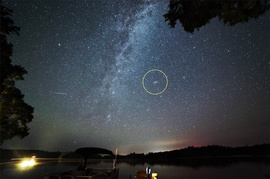The circle in the sky highlights one of the furthest objects the human eye can see without optical aid. The Andromeda Galaxy (M31) lies 2.5 million light-years away and requires dark moonless skies far from city lights and dark adapted pupils. When you see the light from this approaching spiral galaxy you're looking at photons that took 2.5 million years to arrive at the Earth and no Homo Sapiens when it left on it's journey to your eye and registered as an image in your 3lb mass of almost 90 billion neurons.



Enjoy being online again!
Welcome to the community of good people who base their values on evidence and appreciate civil discourse - the social network you will enjoy.Create your free account
2 comments
Feel free to reply to any comment by clicking the "Reply" button.Yes, it is a lovely challenge in some ways, where I live, I get about one night a month when the conditions are good enough for a good view of it.
Our night sky is not bad, but far from pitch black. I had some friends down from the city once and I took them on a walk to the pub. It was a good night and they were stunned by the sky, especially the Milky Way which they had never seen before. Trying to add something for their amusement, I told Mary that the ancient Egyptians though that it was shaped like a naked lady, but that I can not see it, and think that some people see naked ladies everywhere, like faces in the forest. But Mary was delighted and swore she could see her plainly. OH well.
Enjoy being online again!
Welcome to the community of good people who base their values on evidence and appreciate civil discourse - the social network you will enjoy.Create your free account
Share this post
Categories
Agnostic does not evaluate or guarantee the accuracy of any content. Read full disclaimer.






